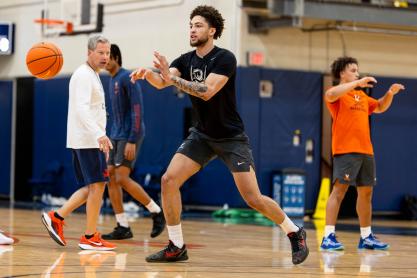Many at the University of Virginia know it has a Faculty Senate, but fewer understand its function and connection to University leadership and decision-making. UVA Today checked in with Faculty Senate Chair James H. Lambert to learn more about the group.

Faculty Senate 2024-2025 Chair James H. Lambert shares facts you may not know about the UVA Faculty Senate. (Photo by Tom Daly)
Q. What does the Faculty Senate do?
A. Composed of 82 faculty representatives from schools across the University, the Faculty Senate’s main role is to represent all faculties within UVA in discussions related to academic functions and actions affecting faculty. The senate also takes part in the approval of new, modified and expiring degree programs, and consults on faculty recruitment efforts and benefits, among other responsibilities. Senate meetings are held once per month throughout the academic year and are open to the public and all members of the University community.
The senate also serves in an advisory function to the University’s Board of Visitors. Each year, the board appoints one faculty member from a group of faculty-elected individuals to hold a non-voting seat on the board. The faculty representative attends and participates in open and closed sessions of board deliberations and meetings.
Q. How does the Faculty Senate interact with University leaders?
A. UVA’s relationship with its Faculty Senate is one of shared governance. University and senate leadership engage proactively to ensure that faculty are aware of ongoing University issues and developments, and to provide University leaders with faculty perspectives to inform decision-making in coordination with the Board of Visitors. Each of the three parts of this shared governance model have important, but separate, responsibilities to uphold the University’s strategic goals of recruiting and retaining excellent faculty, ensuring that University systems allow us all to do our best work, promoting and strengthening a community of trust, and enabling discovery. A source of the senate’s stature is the eminence of its members and other UVA faculty in the arts and sciences, medicine, business, engineering, law, architecture, music, poetry and other scholarship.
Q. Is the University required to take action on Faculty Senate resolutions?
A. Faculty Senate resolutions aren’t required to be adopted by the University. However, University leaders are closely connected to the Faculty Senate to get a clear idea of faculty interests. UVA leadership routinely attends the senate’s Executive Council and regular meetings, offering input and balancing faculty aims and interests with those of the Board of Visitors. That close relationship with University leaders, along with the faculty’s representation on the Board of Visitors, helps faculty concerns be considered and integrated to University actions where possible.
Faculty Senate and Board of Visitors resolutions are an important example of how viewpoints can align, differ and, at times, compete at UVA. University leadership can have a role in balancing among viewpoints and, in collaboration with the Board of Visitors and the senate, charting a path forward.
Q. What are some past examples of Faculty Senate measures that influenced change at UVA?
A. The Faculty Senate has been around since the 1920s, dating back to the administration of UVA’s first president, Edwin A. Alderman. The chairs of the faculty extend back even further in the University’s history.
An important milestone to highlight is the senate gaining formal representation on the UVA Board of Visitors. Around the time of the 2012 board action to remove then-UVA President Teresa A. Sullivan, a push for greater transparency and a stronger relationship among the Faculty Senate, the University administration and the Board of Visitors led to a non-voting faculty member seat at the table, insight to board decisions affecting faculty, and an opportunity to amplify faculty voices for decision-makers.






.jpg)


